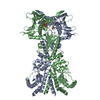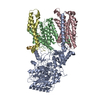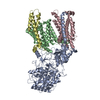+ Open data
Open data
- Basic information
Basic information
| Entry | Database: EMDB / ID: EMD-23214 | |||||||||
|---|---|---|---|---|---|---|---|---|---|---|
| Title | Cryo-EM structure of Hsp90:p23 closed-state complex | |||||||||
 Map data Map data | ||||||||||
 Sample Sample |
| |||||||||
 Keywords Keywords | CHAPERONE | |||||||||
| Function / homology |  Function and homology information Function and homology informationlung saccule development / prostaglandin-E synthase / prostaglandin-E synthase activity / nuclear receptor-mediated glucocorticoid signaling pathway / prostanoid biosynthetic process / Aryl hydrocarbon receptor signalling / Synthesis of Prostaglandins (PG) and Thromboxanes (TX) / glycogen biosynthetic process / telomerase holoenzyme complex / protein folding chaperone complex ...lung saccule development / prostaglandin-E synthase / prostaglandin-E synthase activity / nuclear receptor-mediated glucocorticoid signaling pathway / prostanoid biosynthetic process / Aryl hydrocarbon receptor signalling / Synthesis of Prostaglandins (PG) and Thromboxanes (TX) / glycogen biosynthetic process / telomerase holoenzyme complex / protein folding chaperone complex / prostaglandin biosynthetic process / sperm mitochondrial sheath / sulfonylurea receptor binding / dATP binding / CTP binding / positive regulation of protein polymerization / vRNP Assembly / Scavenging by Class F Receptors / UTP binding / skin development / sperm plasma membrane / chaperone-mediated autophagy / Rho GDP-dissociation inhibitor binding / Respiratory syncytial virus genome replication / telomerase holoenzyme complex assembly / mitochondrial transport / protein insertion into mitochondrial outer membrane / Uptake and function of diphtheria toxin / Drug-mediated inhibition of ERBB2 signaling / Resistance of ERBB2 KD mutants to trastuzumab / Resistance of ERBB2 KD mutants to sapitinib / Resistance of ERBB2 KD mutants to tesevatinib / Resistance of ERBB2 KD mutants to neratinib / Resistance of ERBB2 KD mutants to osimertinib / Resistance of ERBB2 KD mutants to afatinib / Resistance of ERBB2 KD mutants to AEE788 / Resistance of ERBB2 KD mutants to lapatinib / Drug resistance in ERBB2 TMD/JMD mutants / TPR domain binding / PIWI-interacting RNA (piRNA) biogenesis / Assembly and release of respiratory syncytial virus (RSV) virions / non-chaperonin molecular chaperone ATPase / dendritic growth cone / : / Sema3A PAK dependent Axon repulsion / protein unfolding / positive regulation of cell size / regulation of protein ubiquitination / HSF1-dependent transactivation / response to unfolded protein / skeletal muscle contraction / regulation of postsynaptic membrane neurotransmitter receptor levels / regulation of protein-containing complex assembly / HSF1 activation / telomere maintenance via telomerase / chaperone-mediated protein complex assembly / Attenuation phase / neurofibrillary tangle assembly / RHOBTB2 GTPase cycle / axonal growth cone / positive regulation of lamellipodium assembly / eNOS activation / DNA polymerase binding / Tetrahydrobiopterin (BH4) synthesis, recycling, salvage and regulation / positive regulation of defense response to virus by host / response to salt stress / Signaling by ERBB2 / cardiac muscle cell apoptotic process / positive regulation of telomere maintenance via telomerase / endocytic vesicle lumen / positive regulation of cardiac muscle contraction / Loss of Nlp from mitotic centrosomes / Loss of proteins required for interphase microtubule organization from the centrosome / nitric-oxide synthase regulator activity / telomere maintenance / Recruitment of mitotic centrosome proteins and complexes / activation of innate immune response / Recruitment of NuMA to mitotic centrosomes / Anchoring of the basal body to the plasma membrane / lysosomal lumen / positive regulation of interferon-beta production / response to cold / HSP90 chaperone cycle for steroid hormone receptors (SHR) in the presence of ligand / ESR-mediated signaling / Constitutive Signaling by Overexpressed ERBB2 / protein tyrosine kinase binding / AURKA Activation by TPX2 / VEGFR2 mediated vascular permeability / Hsp90 protein binding / ATP-dependent protein folding chaperone / response to cocaine / neuron migration / Signaling by ERBB2 TMD/JMD mutants / brush border membrane / Constitutive Signaling by EGFRvIII / Signaling by ERBB2 ECD mutants / tau protein binding / Signaling by ERBB2 KD Mutants / DDX58/IFIH1-mediated induction of interferon-alpha/beta / cellular response to virus Similarity search - Function | |||||||||
| Biological species |  Homo sapiens (human) Homo sapiens (human) | |||||||||
| Method | single particle reconstruction / cryo EM / Resolution: 3.1 Å | |||||||||
 Authors Authors | Lee K / Thwin AC | |||||||||
| Funding support |  United States, 2 items United States, 2 items
| |||||||||
 Citation Citation |  Journal: Mol Cell / Year: 2021 Journal: Mol Cell / Year: 2021Title: The structure of an Hsp90-immunophilin complex reveals cochaperone recognition of the client maturation state. Authors: Kanghyun Lee / Aye C Thwin / Cory M Nadel / Eric Tse / Stephanie N Gates / Jason E Gestwicki / Daniel R Southworth /  Abstract: The Hsp90 chaperone promotes folding and activation of hundreds of client proteins in the cell through an ATP-dependent conformational cycle guided by distinct cochaperone regulators. The FKBP51 ...The Hsp90 chaperone promotes folding and activation of hundreds of client proteins in the cell through an ATP-dependent conformational cycle guided by distinct cochaperone regulators. The FKBP51 immunophilin binds Hsp90 with its tetratricopeptide repeat (TPR) domain and catalyzes peptidyl-prolyl isomerase (PPIase) activity during folding of kinases, nuclear receptors, and tau. Here we determined the cryoelectron microscopy (cryo-EM) structure of the human Hsp90:FKBP51:p23 complex to 3.3 Å, which, together with mutagenesis and crosslinking analyses, reveals the basis for cochaperone binding to Hsp90 during client maturation. A helix extension in the TPR functions as a key recognition element, interacting across the Hsp90 C-terminal dimer interface presented in the closed, ATP conformation. The PPIase domain is positioned along the middle domain, adjacent to Hsp90 client binding sites, whereas a single p23 makes stabilizing interactions with the N-terminal dimer. With this architecture, FKBP51 is positioned to act on specific client residues presented during Hsp90-catalyzed remodeling. | |||||||||
| History |
|
- Structure visualization
Structure visualization
| Movie |
 Movie viewer Movie viewer |
|---|---|
| Structure viewer | EM map:  SurfView SurfView Molmil Molmil Jmol/JSmol Jmol/JSmol |
| Supplemental images |
- Downloads & links
Downloads & links
-EMDB archive
| Map data |  emd_23214.map.gz emd_23214.map.gz | 179.4 MB |  EMDB map data format EMDB map data format | |
|---|---|---|---|---|
| Header (meta data) |  emd-23214-v30.xml emd-23214-v30.xml emd-23214.xml emd-23214.xml | 12.7 KB 12.7 KB | Display Display |  EMDB header EMDB header |
| Images |  emd_23214.png emd_23214.png | 27 KB | ||
| Filedesc metadata |  emd-23214.cif.gz emd-23214.cif.gz | 5.6 KB | ||
| Archive directory |  http://ftp.pdbj.org/pub/emdb/structures/EMD-23214 http://ftp.pdbj.org/pub/emdb/structures/EMD-23214 ftp://ftp.pdbj.org/pub/emdb/structures/EMD-23214 ftp://ftp.pdbj.org/pub/emdb/structures/EMD-23214 | HTTPS FTP |
-Validation report
| Summary document |  emd_23214_validation.pdf.gz emd_23214_validation.pdf.gz | 486.3 KB | Display |  EMDB validaton report EMDB validaton report |
|---|---|---|---|---|
| Full document |  emd_23214_full_validation.pdf.gz emd_23214_full_validation.pdf.gz | 485.9 KB | Display | |
| Data in XML |  emd_23214_validation.xml.gz emd_23214_validation.xml.gz | 7 KB | Display | |
| Data in CIF |  emd_23214_validation.cif.gz emd_23214_validation.cif.gz | 8 KB | Display | |
| Arichive directory |  https://ftp.pdbj.org/pub/emdb/validation_reports/EMD-23214 https://ftp.pdbj.org/pub/emdb/validation_reports/EMD-23214 ftp://ftp.pdbj.org/pub/emdb/validation_reports/EMD-23214 ftp://ftp.pdbj.org/pub/emdb/validation_reports/EMD-23214 | HTTPS FTP |
-Related structure data
| Related structure data |  7l7jMC  7l7iC C: citing same article ( M: atomic model generated by this map |
|---|---|
| Similar structure data |
- Links
Links
| EMDB pages |  EMDB (EBI/PDBe) / EMDB (EBI/PDBe) /  EMDataResource EMDataResource |
|---|---|
| Related items in Molecule of the Month |
- Map
Map
| File |  Download / File: emd_23214.map.gz / Format: CCP4 / Size: 190.1 MB / Type: IMAGE STORED AS FLOATING POINT NUMBER (4 BYTES) Download / File: emd_23214.map.gz / Format: CCP4 / Size: 190.1 MB / Type: IMAGE STORED AS FLOATING POINT NUMBER (4 BYTES) | ||||||||||||||||||||||||||||||||||||||||||||||||||||||||||||
|---|---|---|---|---|---|---|---|---|---|---|---|---|---|---|---|---|---|---|---|---|---|---|---|---|---|---|---|---|---|---|---|---|---|---|---|---|---|---|---|---|---|---|---|---|---|---|---|---|---|---|---|---|---|---|---|---|---|---|---|---|---|
| Projections & slices | Image control
Images are generated by Spider. | ||||||||||||||||||||||||||||||||||||||||||||||||||||||||||||
| Voxel size | X=Y=Z: 0.814 Å | ||||||||||||||||||||||||||||||||||||||||||||||||||||||||||||
| Density |
| ||||||||||||||||||||||||||||||||||||||||||||||||||||||||||||
| Symmetry | Space group: 1 | ||||||||||||||||||||||||||||||||||||||||||||||||||||||||||||
| Details | EMDB XML:
CCP4 map header:
| ||||||||||||||||||||||||||||||||||||||||||||||||||||||||||||
-Supplemental data
- Sample components
Sample components
-Entire : Hsp90:p23 closed-state complex
| Entire | Name: Hsp90:p23 closed-state complex |
|---|---|
| Components |
|
-Supramolecule #1: Hsp90:p23 closed-state complex
| Supramolecule | Name: Hsp90:p23 closed-state complex / type: complex / ID: 1 / Parent: 0 / Macromolecule list: #1-#2 |
|---|---|
| Source (natural) | Organism:  Homo sapiens (human) Homo sapiens (human) |
-Macromolecule #1: Prostaglandin E synthase 3
| Macromolecule | Name: Prostaglandin E synthase 3 / type: protein_or_peptide / ID: 1 / Number of copies: 1 / Enantiomer: LEVO / EC number: prostaglandin-E synthase |
|---|---|
| Source (natural) | Organism:  Homo sapiens (human) Homo sapiens (human) |
| Molecular weight | Theoretical: 18.720395 KDa |
| Recombinant expression | Organism:  |
| Sequence | String: MQPASAKWYD RRDYVFIEFC VEDSKDVNVN FEKSKLTFSC LGGSDNFKHL NEIDLFHCID PNDSKHKRTD RSILCCLRKG ESGQSWPRL TKERAKLNWL SVDFNNWKDW EDDSDEDMSN FDRFSEMMNN MGGDEDVDLP EVDGADDDSQ DSDDEKMPDL E UniProtKB: Prostaglandin E synthase 3 |
-Macromolecule #2: Heat shock protein HSP 90-alpha
| Macromolecule | Name: Heat shock protein HSP 90-alpha / type: protein_or_peptide / ID: 2 / Number of copies: 2 / Enantiomer: LEVO |
|---|---|
| Source (natural) | Organism:  Homo sapiens (human) Homo sapiens (human) |
| Molecular weight | Theoretical: 84.781727 KDa |
| Recombinant expression | Organism:  |
| Sequence | String: MPEETQTQDQ PMEEEEVETF AFQAEIAQLM SLIINTFYSN KEIFLRELIS NSSDALDKIR YESLTDPSKL DSGKELHINL IPNKQDRTL TIVDTGIGMT KADLINNLGT IAKSGTKAFM EALQAGADIS MIGQFGVGFY SAYLVAEKVT VITKHNDDEQ Y AWESSAGG ...String: MPEETQTQDQ PMEEEEVETF AFQAEIAQLM SLIINTFYSN KEIFLRELIS NSSDALDKIR YESLTDPSKL DSGKELHINL IPNKQDRTL TIVDTGIGMT KADLINNLGT IAKSGTKAFM EALQAGADIS MIGQFGVGFY SAYLVAEKVT VITKHNDDEQ Y AWESSAGG SFTVRTDTGE PMGRGTKVIL HLKEDQTEYL EERRIKEIVK KHSQFIGYPI TLFVEKERDK EVSDDEAEEK ED KEEEKEK EEKESEDKPE IEDVGSDEEE EKKDGDKKKK KKIKEKYIDQ EELNKTKPIW TRNPDDITNE EYGEFYKSLT NDW EDHLAV KHFSVEGQLE FRALLFVPRR APFDLFENRK KKNNIKLYVR RVFIMDNCEE LIPEYLNFIR GVVDSEDLPL NISR EMLQQ SKILKVIRKN LVKKCLELFT ELAEDKENYK KFYEQFSKNI KLGIHEDSQN RKKLSELLRY YTSASGDEMV SLKDY CTRM KENQKHIYYI TGETKDQVAN SAFVERLRKH GLEVIYMIEP IDEYCVQQLK EFEGKTLVSV TKEGLELPED EEEKKK QEE KKTKFENLCK IMKDILEKKV EKVVVSNRLV TSPCCIVTST YGWTANMERI MKAQALRDNS TMGYMAAKKH LEINPDH SI IETLRQKAEA DKNDKSVKDL VILLYETALL SSGFSLEDPQ THANRIYRMI KLGLGIDEDD PTADDTSAAV TEEMPPLE G DDDTSRMEEV D UniProtKB: Heat shock protein HSP 90-alpha |
-Macromolecule #3: PHOSPHOAMINOPHOSPHONIC ACID-ADENYLATE ESTER
| Macromolecule | Name: PHOSPHOAMINOPHOSPHONIC ACID-ADENYLATE ESTER / type: ligand / ID: 3 / Number of copies: 2 / Formula: ANP |
|---|---|
| Molecular weight | Theoretical: 506.196 Da |
| Chemical component information |  ChemComp-ANP: |
-Experimental details
-Structure determination
| Method | cryo EM |
|---|---|
 Processing Processing | single particle reconstruction |
| Aggregation state | particle |
- Sample preparation
Sample preparation
| Buffer | pH: 7.5 |
|---|---|
| Vitrification | Cryogen name: ETHANE |
- Electron microscopy
Electron microscopy
| Microscope | FEI TITAN KRIOS |
|---|---|
| Image recording | #0 - Image recording ID: 1 / #0 - Film or detector model: GATAN K2 SUMMIT (4k x 4k) / #0 - Average electron dose: 70.0 e/Å2 / #1 - Image recording ID: 2 / #1 - Film or detector model: GATAN K3 BIOQUANTUM (6k x 4k) / #1 - Average electron dose: 66.0 e/Å2 |
| Electron beam | Acceleration voltage: 300 kV / Electron source:  FIELD EMISSION GUN FIELD EMISSION GUN |
| Electron optics | Illumination mode: FLOOD BEAM / Imaging mode: BRIGHT FIELD |
| Experimental equipment |  Model: Titan Krios / Image courtesy: FEI Company |
 Movie
Movie Controller
Controller


































 Z (Sec.)
Z (Sec.) Y (Row.)
Y (Row.) X (Col.)
X (Col.)























